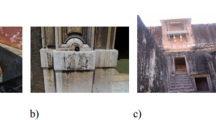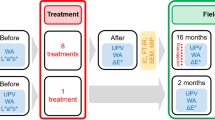Abstract
Phototrophic microorganisms disfigure the surfaces of different types of stone. Stone structure is damaged by the activity of photoautotrophic and other microorganisms. However, to date few, investigations have been undertaken into the relationship between microorganisms and the properties of different types of marble. In this study, biological activity of photoautotrophic microorganisms on three types of marble (Yatagan White, Giallo Anticato and Afyon White) was investigated under laboratory conditions over a short period of time. The three types of marble supported the growth of phototrophic microbial communities on their outer and inner layers, turning their original colour from white to a yellowish green colour. The porosity of the marble types facilitated filamentous microbial growth in the presence of water. Scanning electron microscope analysis revealed the accumulation of aggregates such as small spherical, fibrillar, calcified globular bodies on the inner surfaces of the marbles. This suggests that the microscopic characteristics of particular marble types may stimulate the growth of certain types of microorganisms.




Similar content being viewed by others
References
Cappitelli F, Principi P, Pedrazzani R, Toniolo L, Sorlini C (2007) Bacterial and fungal deterioration of the Milan Cathedral marble treated with protective synthetic resins. Sci Total Environ 385:172–181
Crispim CA, Gaylarde CC (2005) Cyanobacteria and biodeterioration of cultural heritage: a review. Microb Ecol 49:1–9
Crispim CA, Gaylarde PM, Gaylarde CC (2003) Algal and cyanobacterial biofilms on calcareous historic buildings. Curr Microbiol 46:79–82
Gaylarde PM, Gaylarde CC (1999) Algae and cyanobacteria on painted surfaces in Southern Brazil. Rev Microbiol 30:209–213
Gaylarde PM, Gaylarde CC, Guiamet PS, de Gomez SG, Videla HA (2001) Biodeterioration of Mayan buildings at Uxmal and Tulum, Mexico. Biofouling 17:41–45
Gorbushina AA, Broughton WJ (2009) Microbiology of the atmosphere-rock interface: how biological interactions and physical stresses modulate a sophisticated microbial ecosystem. Annu Rev Microbiol 63:431–450
Guiamet P, Borrego S, Lavin P, Perdomo I, Saravia SG (2011) Biofouling and biodeterioration in materials stored at the historical archive of the museum of La Plata, Argentine and at the National Archive of the Republic of Cuba. Colloids Surf B: Biointerfaces 85:229–234
Guiamet P, Crespo M, Lavin P, Ponce B, Gaylarde C, Saravia SG (2013) Biodeterioration of funeral sculptures in La Recoleta Cemetery, Buenos Aires, Argentina: pre- and post-intervention studies. Colloids Surf B: Biointerfaces 101:337–342
Hoppert M, Flies C, Pohl W, Günzl B, Schneider J (2004) Colonization strategies of lithobiontic microorganisms on carbonate rocks. Environ Geol 46:421–428
Karaca Z, Öztürk A, Ünsal T (2011) In: Baby S, Zygmunth B (eds) A comparative study on the activity of oxygenic photosynthetic consortia on marble and granite. 2nd International Conference on Environmental Science and Technology (ICEST 2011), IEEE, Singapore, pp 447–451
Noack-Schönmann S, Spagin O, Gründer K-P, Breithaupt M, Günter A, Muschik B, Gorbushina AA (2014) Sub-aerial biofilms as blockers of solar radiation: spectral properties as tools to characterise material-relevant microbial growth. Int Biodeterior Biodegrad 86:286–293
Nuhoglu Y, Oguz E, Uslu H, Ozbek A, Ipekoglu B, Ocak I, Hasenekolu I (2006) The accelerating effects of the microorganisms on biodeterioration of stone monuments under air pollution and continental-cold climatic conditions in Erzurum, Turkey. Sci Total Environ 364:272–283
Ozturk A, Karaca Z, Unsal T (2014) The activity of oxygenic photosynthetic microbial consortia on different granites. Ekoloji 23(90):90–96
Rippka R, Deruelles J, Waterbury JB, Herdman M, Stanier RY (1979) Generic assignments, strain histories and properties of pure cultures of cyanobacteria. J Gen Microbiol 111:1–61
Sedmak B, Kosi G (1998) The role of microcystins in heavy cyanobacterial bloom formation. J Plankton Res 20:691–708
Seiffert F, Bandowa N, Bouchez J, Blanckenburg F, Gorbushina AA (2014) Microbial colonization of bare rocks: laboratory biofilm enhances mineral weathering. Procedia Earth Planet Sci 10:123–129
TS 699 (2009) Natural building stones—methods of inspection and laboratory testing. Institute of Turkish Standards, Ankara
Uher B (2008) Spatial distribution of cyanobacteria and algae from the tombstone in a historic cemetery in Bratislava, Slovakia. Fottea 9:81–92
Warscheid T, Braams J (2000) Biodeterioration of stone: a review. Int Biodeterior Biodegrad 46:343–368
World Health Organization (2003) Cyanobacterial toxins: microcystin-LR in drinking-water. WHO/SDE/WSH/03.04/57, 2nd edn. 2:14
Zagari M, Antonelli F, Urzi C (2000) Biological patinas on the limestones of the Loches Romanic tower (Touraine, France). In: Fassina V (ed) Proceedings of 9th International Congress on Deterioration and Conservation of Stone, Elsevier, pp 445–451
Acknowledgments
This research, which was conducted by the corresponding author, was financially supported by the Office of Scientific Research Projects of Niğde University, Niğde, under the code FEB 2010/31. The authors would like to extend their gratitude to Niğde University for her generosity.
Compliance with ethical standards
The authors declare that there is no conflict of interest with any financial organization regarding the material discussed in the manuscript. Funding bodies played no part in the design or undertaking of the study. The research did not involve any human or animal participants.
Declaration of obedience to ethical standards
The authors hereby state and declare that they strictly did obey the ethical standards during and thereafter the research or documenting process and do accept all responsibilities that would likely be arisen by any third parties other than the authors themselves and the journal Environmental Science and Pollution Research. Moreover, the following rules have also been considered in preparation of the manuscript, which are
-
The manuscript has not been submitted to more than one journal for simultaneous consideration.
-
The manuscript has not been published previously (partly or in full), unless the new work concerns an expansion of previous work (please provide transparency on the reuse of material to avoid the hint of text-recycling (self-plagiarism)).
-
A single study is not split up into several parts to increase the quantity of submissions and submitted to various journals or to one journal over time (e.g. salami publishing).
-
No data have been fabricated or manipulated (including images) to support your conclusions.
-
No data, text or theories by others are presented as if they were the authors’ own. Proper acknowledgements to other works have been given.
-
The authors authorize the journal to use any kind of software to screen for plagiarism.
-
Authors whose names appear on the submission have contributed sufficiently to the scientific work and therefore share collective responsibility and accountability for the results.
Author information
Authors and Affiliations
Corresponding author
Additional information
Responsible editor: Philippe Garrigues
Zeki Karaca holds a Ph.D., Çanakkale Onsekizmart University.
Ayten Öztürk holds a Ph.D., Niğde University.
Rights and permissions
About this article
Cite this article
Karaca, Z., Öztürk, A. & Çolak, E. Biofouling of marbles by oxygenic photosynthetic microorganisms. Environ Sci Pollut Res 22, 11285–11289 (2015). https://doi.org/10.1007/s11356-015-4366-1
Received:
Accepted:
Published:
Issue Date:
DOI: https://doi.org/10.1007/s11356-015-4366-1




